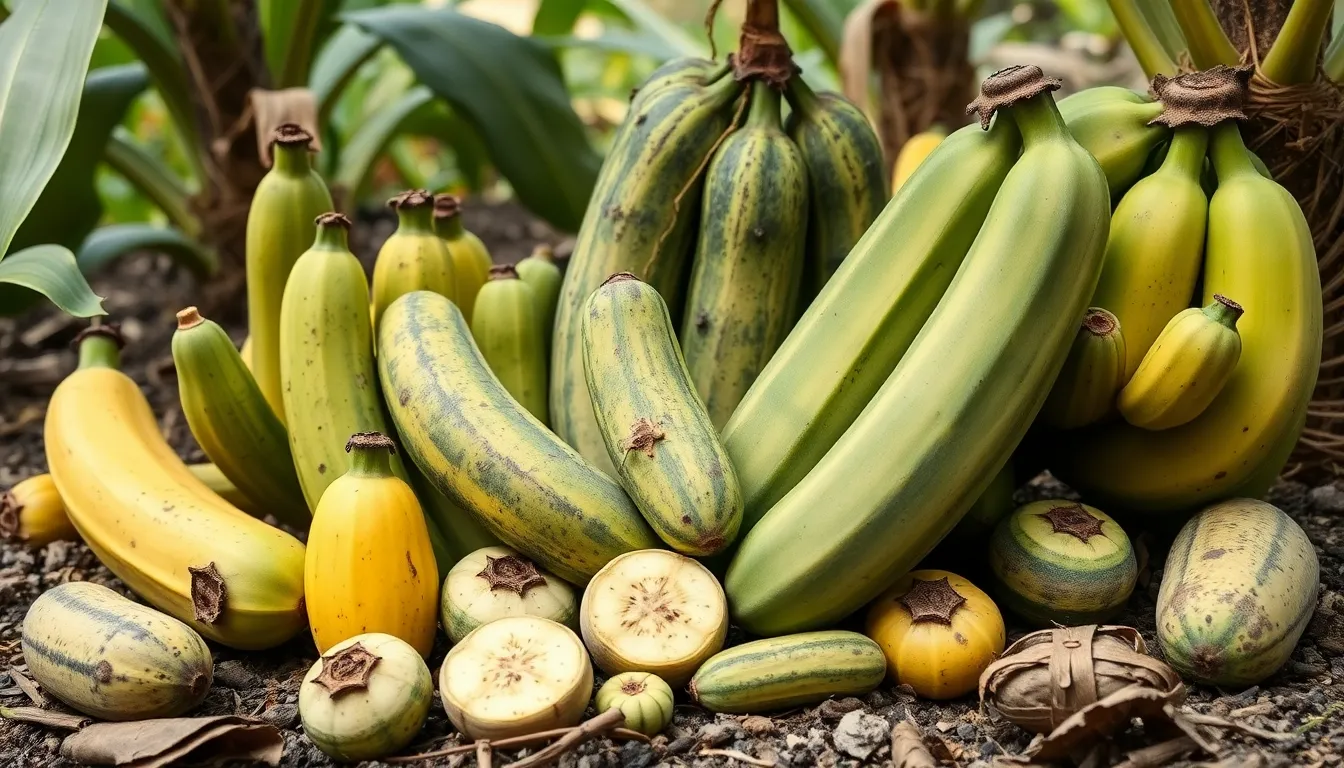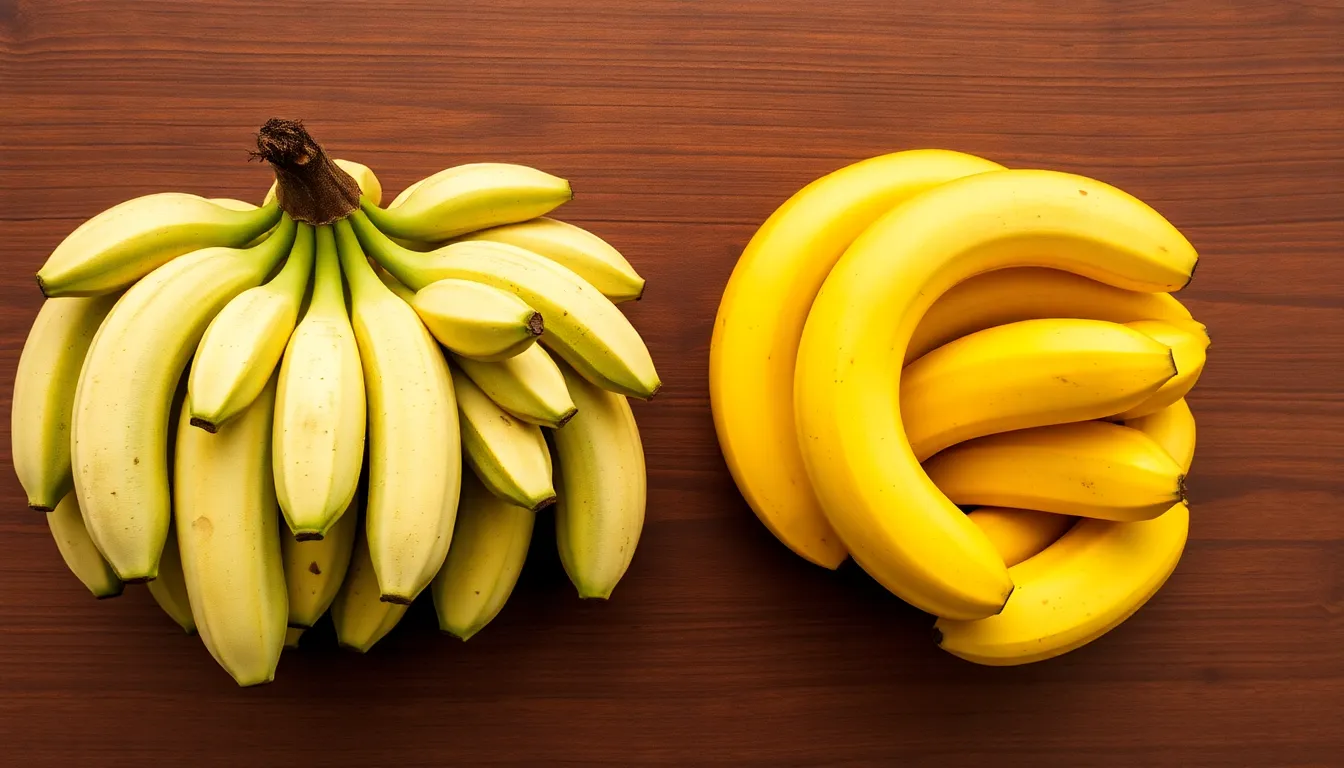Bananas today are the epitome of yellow perfection, but what if we told you they weren’t always the snackable wonders we know and love? Picture this: a banana that looks like a mutant cucumber and tastes like a sad potato. Sounds appetizing, right?
Table of Contents
ToggleThe Origins of Bananas
Bananas trace their roots back thousands of years, showing remarkable transformation over time. Early varieties looked quite different from today’s familiar fruit.
Wild Ancestors of Modern Bananas
Wild ancestors of modern bananas include species such as Musa acuminata and Musa balbisiana. These ancestors produced small, seeded fruits that had an unpleasant flavor. Native to Southeast Asia, these wild bananas had tough skins and contained large seeds, making them less enjoyable for consumption. Their cultivation relied on wild plants, which provided a harsh diet compared to today’s sweet and seedless formats.
Early Cultivation Practices
Early cultivation practices began around 5000 BCE, focusing on the selective breeding of banana plants. Societies in Papua New Guinea cultivated bananas for food, enhancing their size and taste. These early farmers recognized the plant’s potential, creating varieties that thrived in specific climates. The transition from wild to cultivated bananas marked a critical step in agricultural history, as people sought ways to improve their food sources. Early cultivation practices laid the foundation for the tasty bananas enjoyed globally today.
The Appearance of Ancient Bananas

Ancient bananas presented a stark contrast to the varieties known today. Early fruits typically measured around 4 to 6 inches long, resembling mutant cucumbers rather than the familiar yellow bananas. Their shape varied significantly, with some being more elongated while others were short and stubby.
Size and Shape Variations
Size and shape among ancient bananas varied widely. Most early bananas were significantly smaller than modern counterparts, typically around 1 to 2 inches in diameter. Shape also deviated; some cultivated types appeared more rounded, while others were elongated. Variations resulted from natural crossbreeding and selective cultivation methods. Many wild bananas showcased irregular shapes, reflecting their wild lineage. Through generations of selective breeding, cultivators aimed to enhance size, leading to the more uniform shapes seen in today’s cultivated bananas.
Color and Texture Differences
Color and texture of ancient bananas differed notably from the bright yellow varieties today. Most wild bananas sported a green or pale hue than transitioned to a dull yellow or brown when ripe. In comparison, cultivated varieties today exhibit vibrant colors and a smooth, appealing texture. Ancient bananas often came with a tougher skin, making them less palatable. This tough skin provided natural protection but resulted in a less enjoyable eating experience. Over time, breeding efforts focused on producing softer-skinned bananas that provided a sweeter and more appealing taste.
The Transition to Modern Bananas
The evolution of bananas from their wild ancestors to today’s cultivars highlights significant changes in appearance and taste.
Domestication and Genetic Changes
Domestication began around 5000 BCE in Papua New Guinea with selective breeding practices. Early cultivators aimed to enhance size and sweetness, leading to genetic changes in banana plants. Musa acuminata and Musa balbisiana served as primary ancestors for cultivated varieties. Fruits produced by these plants were small and contained many seeds, which contrasted sharply with contemporary varieties that are seedless and larger. Over generations, the focus shifted towards developing plants with softer skins and a more desirable flavor profile.
The Role of Agriculture in Banana Evolution
Agriculture played a pivotal role in the transformation of bananas. Farmers established techniques that improved yield and minimized disease, ensuring better quality fruits. Techniques included propagating bananas through suckers, allowing for consistent characteristics in the harvest. Advancements in farming practices led to a wider distribution of bananas across various regions, changing cultivation methods and consumer preferences. As a result, modern bananas became synonymous with convenience, taste, and nutritional value, differentiating them significantly from their wild predecessors.
Modern Varieties of Bananas
Today’s bananas showcase dramatic advancements from their historical forms. Those cultivated varieties deliver taste, texture, and appearance that appeal to consumers worldwide.
The Cavendish Dominance
Cavendish bananas dominate global production, accounting for approximately 47% of the total banana market. They gained popularity in the 20th century due to their resistance to various diseases. Retailers prefer their uniform shape and long shelf life, making them a staple in grocery stores. This widespread cultivation centers on the Cavendish’s ability to withstand transportation. However, reliance on a single variety raises concerns about vulnerability to future diseases.
Other Popular Banana Varieties
Apart from Cavendish, other banana varieties contribute to global diversity. Red bananas, for example, feature a reddish-purple skin and a sweet, creamy taste. Lady Finger bananas, smaller and sweeter, gain favor for snacking. Plantains, which are starchier, serve culinary uses, particularly in savory dishes. These varieties enrich the market and offer distinct flavor profiles. As awareness grows, consumers increasingly seek out these alternative banana options.
The transformation of bananas from their wild ancestors to the cultivated varieties enjoyed today is nothing short of remarkable. This evolution showcases the ingenuity of early agricultural practices and the impact of selective breeding on taste and appearance. Modern bananas not only provide convenience and nutrition but also reflect a rich history of adaptation and change. As consumers become more aware of different banana varieties, the market continues to diversify beyond the popular Cavendish. The journey of bananas serves as a fascinating example of how human intervention has shaped the foods we consume, making them more appealing and accessible than ever before.





